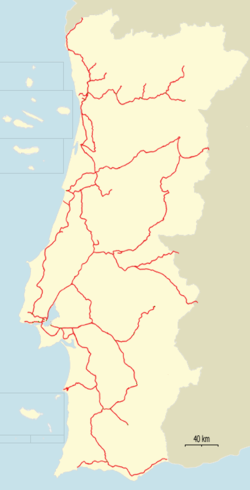Comboios de Portugal
 | |
| Company type | Incorporation |
|---|---|
| Industry | Rail transport |
| Predecessor | Portuguese Railway Company |
| Founded | 1975 |
| Headquarters | , |
Key people | Nuno Pinho da Cruz Leite de Freitas, Pedro Miguel Sousa Pereira Guedes Moreira, Ana Maria dos Santos Malhó, Maria Isabel de Magalhães Ribeiro, Pedro Manuel Franco Ribeiro |
| Products | Rail Transport (Passenger) |
| Revenue | |
| Owner | Government of Portugal (100%) |
Number of employees | 2,658 (2018)[1] |
| Website | www.cp.pt |
| Comboios de Portugal | |
|---|---|
 Map showing the railway lines in Portugal operated by CP in 2007. Some lines have been closed since.  A CP freight train in 2009 | |
| Track gauge | 1,668 mm (5 ft 5 21⁄32 in) Iberian gauge and 1,000 mm (3 ft 3 3⁄8 in) metre gauge |



Comboios de Portugal, (CP; English: Trains of Portugal) is a state-owned company which operates passenger trains in Portugal.
It started in October 1856 with the opening of the first railway line in Portugal. Most of the network is Iberian gauge lines, as in Spain. During the 1950s, the Portuguese railway network was about 3,750 km (2,330 mi), its greatest extent. In 1975, the Portuguese Railway Company was nationalised When passenger numbers decreased, various lines were shut down, with almost a quarter of the rail network being closed by the twenty-first century.[2]
During 1999, it introduced a new service, the Alfa Pendular, which operates between Braga - Porto - Lisbon - Faro using tilting trains. Since 2005 the company runs only passenger train services. Management of the railway infrastructure is done by Infraestruturas de Portugal . Cargo activities were transferred to private company MSC who operate them under the Medway label. In 2015, a new long-term strategy for Portugal's railway network was started. The full electrification of the network, the provision of European Rail Traffic Management System (ERTMS), and the general modernisation and improvement of trunk routes and international services is being conducted.
Network[change | change source]
- Broad gauge (1,668 mm (5 ft 5+21⁄32 in)): 2,603 km (1,617 mi), 1,351 km (839 mi) electrified at 25 kV 50 Hz AC and 25 km (16 mi) at 1.5 kV DC.
- Narrow gauge (metre gauge) 1,000 mm (3 ft 3+3⁄8 in): 188 km (117 mi) not electrified.
- The maximum extent of 3,592 km (2,232 mi) was reached in 1949, but in the late 1980s and early 1990s some lines were shortened and some totally closed.
References[change | change source]
- ↑ 1.0 1.1 1.2 1.3 Comboios de Portugal (2018). "Relatório & Contas Consolidado" (PDF) (in Portuguese).
- ↑ "The Portuguese Railway: 160 years and 160 more". Global Railway Review. Retrieved 2024-03-11.
